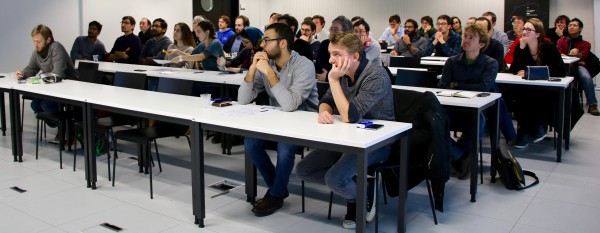MARVEL Junior Seminar — November 2020
Zoom meeting link:
https://epfl.zoom.us/j/93881551248
Password: 3417
The MARVEL Junior Seminars aim to intensify interactions between the MARVEL Junior scientists belonging to different research groups.
Each seminar consists of two presentations of 25 minutes each, allowing to present on a scientific question in depth, followed by time for discussion. The discussion is facilitated and timed by the chair.

MARVEL Junior Seminar Organizing Committee — Michele Kotiuga, Sara Fiore, Stefano Falletta, Kristians Cernevics, Max Veit and Patrick Mayor
Talk 1 — Dielectric-dependent hybrid functionals for band gaps of inorganic halide perovskites with phonon and spin-orbit coupling impacts
Haiyuan Wang, Thomas Bischoff, Patrick Gono, and Alfredo Pasquarello
Chair of Atomic Scale Simulation (CSEA), EPFL
We performed first-principle calculations of electronic band gap of halide perovskites with the class of ABX3(A = Rb, Cs; B = Ge, Sn, Pb; and X = F, Cl, Br, I). Dielectric-dependent hybrid (DDH) functionals which were recently proved to be accurate and efficient alternatives to that of GW calculations were used to describe the absolute band gap. We then considered the effects of the spin-orbit coupling, nuclear quantum motions and thermal vibrations on the band gap. All the effects yield the crucial band gap renormalization, which improves the band gaps being closer to experimental values. Importantly, in the present work, the temperature-dependent band gap renormalization can be captured only by a single optimal configuration of the atomic positions, so-called special displacement method (SDM). We show that the less computational cost methodologies (DDH and SDM) manifest an accuracy comparable to that of the high-level theories (GW and MD). Hence, this will be exceedingly useful to accurately and efficiently predict the band information at the finite temperature for large extended systems.
Talk 2 — Quantum paraelectricity in SrTiO3 and KTaO3 from density functional theory
Tobias Esswein, Nicola Spaldin
Materials Theory, Dept. of Materials, ETHZ
Quantum paraelectric materials are materials where the incipient ferroelectric phase transition is suppressed by quantum fluctuations. Because standard density functional methods do not capture the quantum nature of the ions, they usually result in a ferroelectric double-well potential for quantum paraelectric materials, such as SrTiO3 and KTaO3. Path integral methods have been shown to correctly capture the quantum nature of the ions, but are very expensive to calculate. We show that including the zero-point energy by straightforward solution of the single-particle Schrödinger equation for the calculated density functional ferroelectric potential energy landscape allows us to correctly distinguish quantum paraelectric phases from conventional paraelectrics and ferroelectrics. Our model also suggests directions for extending the quantum paraelectric regime, which is believed to be relevant for exotic behaviors such as unconventional superconductivity, to higher temperatures.
Check the list of the next MARVEL Junior Seminars here.
Low-volume newsletters, targeted to the scientific and industrial communities.
Subscribe to our newsletter